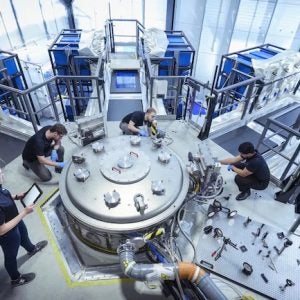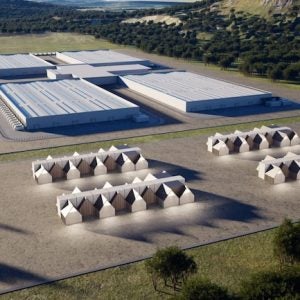 Russia’s SFERA-Pro History site, which investigates significant and little-known events of Russia’s past, has now published a history of Zaporizhia NPP (ZNPP). This includes details of a fire which caused extensive damage during its construction.
Russia’s SFERA-Pro History site, which investigates significant and little-known events of Russia’s past, has now published a history of Zaporizhia NPP (ZNPP). This includes details of a fire which caused extensive damage during its construction.
ZNPP, Europe’s largest nuclear plant is located in the town of Energodar on the bank of the Kakhovka reservoir. However, during its construction a fire broke, which almost led to a large-scale disaster.
After a thermal power plant (Zaporizhia GRES) was put into operation in the late 1970s, it was decided to build a NPP and construction began in 1979. Rem Henoch was appointed head of construction. It was an ambitious project, built using to a new method of continuous construction first used at Zaporizhia GRES.
This involves putting into operation one unit a year which meant that at least four units had to be built at the same time. In addition, it was necessary to create a unique serial model for a power unit with a VVER-1000 reactor. The Soviet leadership planned to build 200 such units in the European part of the USSR by 2010. The key role in this project was assigned to ZNPP.
For such an ambitious construction project, it was necessary to attract at least 10,000 people, which proved very difficult, given the skeptical attitude of Rem Henoch's colleagues. Nevertheless, Henoch was able to find supporters for the serial construction method and convince the Ministry of Energy of its necessity. He also managed to recruit specialists for the construction and people from all over the country came to work at the site. SFERA notes that the services of the military and prisoners were rejected.
The workers enthusiastically participated in the implementation of the unique high-speed in-line method of construction and work continued on several units at once, reducing construction time and labour costs. After four years, the first unit was ready. Its commissioning was scheduled for the beginning of 1984. This was to be marked with a large-scale celebration with those involved being awarded the titles of Hero of Socialist Labour. But on 27 January fire broke out at the unit. Two workers in the technical room noticed smoke from a fire burning below. Local personnel failed to extinguish it and the fire department was called.
It took 18 hours to bring it under control. The PVC insulation caught fire and melted. As it fell it set fire to the cables located below. Fire took hold in the vertical shaft. More than 4,000 control units, 41 electric motors, and 700 km of various cables were burned. The damage was put at 1.5m Soviet rubles.
Fortunately, there was no nuclear fuel in the reactor at the time. “If the fire had occurred after the reactor was loaded with nuclear fuel, then perhaps the tragedy would have eclipsed all other radiation disasters of the 20th century,” SFERA comments.
The equipment damaged by the fire was replaced and work on the second unit continued. After the incident, fire protection was revised. Only non-combustible cables were allowed to be used at nuclear facilities. Also, non-flammable material was used to seal cable passages through walls and ceilings.
The regional Prosecutor's Office opened a criminal case. The cause of the fire was identified as spontaneous combustion in one of the relay units. Leonid Prokhorov, the first director of the NPP, was demoted.
The fact that the reason for the delay in construction was a fire, remained secret and only became known six years later, at the time of glasnost and perestroika.
Nevertheless, the serial construction method performed well. The first unit was put into operation in December 1984. Followed by three others at yearly intervals. In 1989, the fifth unit was launched. Problems arose only with the sixth. After the accident at the Chernobyl NPP in 1986, a moratorium on the construction of nuclear facilities was introduced for three years. After lifting the moratorium, construction resumed. In 1995, unit 6 was put into operation and ZNPP began operating at full capacity.






